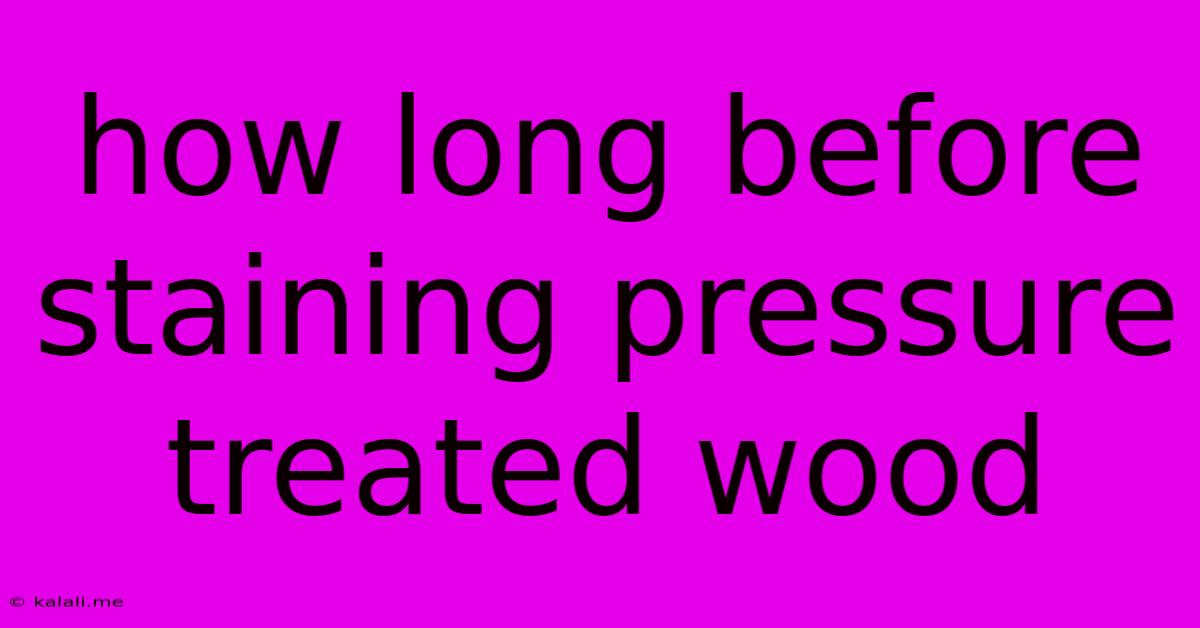How Long Before Staining Pressure Treated Wood
Kalali
Jun 09, 2025 · 3 min read

Table of Contents
How Long Before Staining Pressure Treated Wood? The Complete Guide
Meta Description: Learn how long to wait before staining pressure-treated wood. This guide covers different wood types, treatment types, and weather conditions to ensure a beautiful, long-lasting finish. We'll explore the crucial factors influencing drying time and provide expert tips for success.
Pressure-treated wood offers incredible durability and resistance to rot and insects, making it a popular choice for outdoor projects like decks, fences, and patios. However, before you can achieve that perfect stained finish, you need to understand the crucial waiting period. Rushing the staining process can lead to poor adhesion, peeling, and an overall unsatisfactory result. So, how long should you wait before staining pressure-treated wood? The answer isn't straightforward and depends on several key factors.
Understanding the Drying Process
Pressure treatment involves forcing preservatives deep into the wood's pores under high pressure. This process leaves the wood significantly more moist than untreated lumber. The preservative itself also contributes to the moisture content. Before staining, you need to allow ample time for the wood to dry to a suitable moisture level. Otherwise, the stain won't penetrate properly, and the moisture trapped beneath will cause problems later.
Factors Affecting Drying Time
Several factors influence how long you should wait before staining:
- Type of Wood: Denser woods like cedar or redwood generally dry slower than softer woods like pine.
- Type of Treatment: Different preservatives and treatment methods can affect drying times. Check the manufacturer's instructions for specific recommendations. Some treatments involve a longer drying process than others.
- Wood Thickness: Thicker pieces of lumber will take considerably longer to dry than thinner boards. Consider the dimensions of your lumber when calculating drying time.
- Climate and Weather: Hot, dry, and windy conditions will accelerate drying, while humid and rainy conditions will significantly slow it down. Proper air circulation is crucial.
- Wood's Initial Moisture Content: The moisture content of the wood when it was initially treated will affect how quickly it dries after treatment.
Recommended Waiting Periods
While there's no one-size-fits-all answer, here are some general guidelines:
- Minimum Waiting Time: Most experts recommend waiting at least two to three months before staining pressure-treated wood, regardless of the factors above. This provides sufficient time for some initial drying to occur.
- Ideal Waiting Time: For optimal results, aim for six to twelve months of drying time, particularly in humid climates. This ensures the wood reaches a moisture content suitable for proper stain penetration and adhesion.
Important Note: Always check the manufacturer's recommendations for your specific type of pressure-treated lumber and preservative. They may provide more precise guidelines based on their product.
Testing for Dryness
Before staining, you can test the wood's dryness using a moisture meter. This tool measures the moisture content precisely. While specific moisture content goals can vary based on the type of stain and wood, aim for levels generally recommended for exterior painting or staining of untreated lumber.
Preparing the Wood for Staining
Once the wood is adequately dry, proper surface preparation is crucial for a beautiful and long-lasting finish. This includes:
- Cleaning: Remove any dirt, debris, or mildew with a suitable cleaner.
- Sanding: Lightly sanding the surface will help to create a smoother finish and improve stain penetration.
- Priming (Optional): In some cases, applying a wood primer before staining can enhance the stain's adhesion and longevity.
By following these guidelines and allowing sufficient drying time, you can ensure your pressure-treated wood project is protected and beautifully finished for years to come. Remember patience is key; rushing this process will ultimately lead to less satisfying results.
Latest Posts
Latest Posts
-
Resolver Priming Query Complete Timed Out
Jun 09, 2025
-
What 3d Filament Is Microwave Safe
Jun 09, 2025
-
Shot In The Dark Coffee Drink
Jun 09, 2025
-
How To Get Ahead In Math In High School
Jun 09, 2025
-
How Do You Take Scratches Out Of Stainless Steel
Jun 09, 2025
Related Post
Thank you for visiting our website which covers about How Long Before Staining Pressure Treated Wood . We hope the information provided has been useful to you. Feel free to contact us if you have any questions or need further assistance. See you next time and don't miss to bookmark.